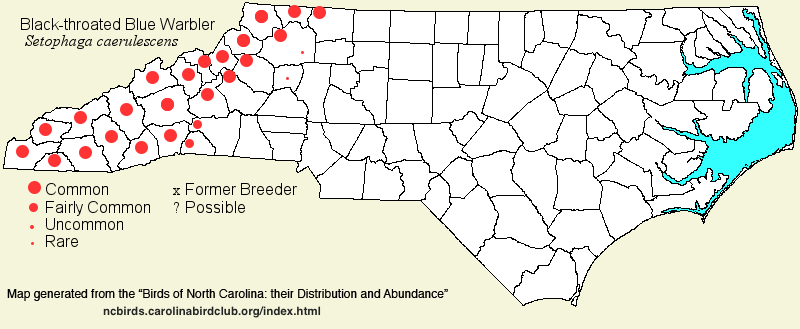 |  |
|
Black-throated Blue Warbler - Setophaga caerulescens PARULIDAE Members: | Search Common: Search Scientific: |
|
|
|||||||
| General Comments | Compared with most warblers, the Black-throated Blue has a relatively small breeding range, found in extreme southeastern Canada and northeastern United States, down the Appalachians to Georgia. Thankfully, within this range it is generally common, and it is certainly so in North Carolina, being an easily heard and seen bird of the middle and higher mountains. As it winters in the West Indies, it migrates through the remainder of the state in spring and fall. Breeders require a fairly dense shrub/sapling layer within a cool montane forest, though the canopy composition can be spruce-fir, pure hardwoods, hemlock (formerly), or White Pine. As evergreen rhododendrons and Mountain Laurel are abundant in cool forests, the Black-throated Blue finds an abundance of suitable habitat for nesting -- mainly above 3,000 feet. Migrants are typically found in the understory or shrub layers, usually hardwoods, within various forest types. | ||||||
| Breeding Status | Breeder | ||||||
| NC BRC List | Definitive | ||||||
| State Status | |||||||
| U.S. Status | |||||||
| State Rank | S4B | ||||||
| Global Rank | G5 | ||||||
| Coastal Plain | Transient, and casually into early winter. In spring, uncommon to fairly common in the western portions, but uncommon in the central and eastern portions; even so, it is one of the more "frequent" of the coniferous forest migrants in the region. In fall, uncommon to fairly common throughout, more likely on the coast (where migrants pile up during migration). Mainly late Apr to mid-May, and early Sep to mid-Oct, sparingly into Nov. Casual to very rare along and near the coast in Dec and early Jan. Out of season, probably an overwintering individual, was a male photographed on 4 Mar 2017 in Aberdeen (Moore). Peak counts: 91, "Outer Banks", 7 Oct 1978. | ||||||
| Piedmont | Transient, and sparse breeder (currently?) in foothill ranges. Fairly common over the region in spring, but uncommon to fairly common in fall; definitely more numerous (or obvious) in the spring season. Reported to be present in summer in the Brushy Mountains as of 1967 [Chat 32:1-4 link]; however, no specifics were provided, and present-day status there or in the South Mountains is uncertain. Casual into Dec and Jan, essentially only along the eastern edge of the region. Notable was one photographed at a feeder near Hillsborough (Orange) for a week in early Jan 2014, as was one at a Chapel Hill (Orange) feeder from 30 Dec 2020 - 21 Feb 2021. Mainly mid- or late Apr to mid-May, and early Sep to mid-Oct; a few winter records. Peak counts: | ||||||
| Mountains | Summer resident, and transient. In summer, common and relatively widespread over the province, mainly between 2,500 and 5,500 feet; rarely to 2,000 feet. Probably a fairly common migrant in spring and uncommon in fall, at low elevations. Mainly mid-Apr to mid-Oct. Remarkable was a male in Transylvania, from 20 Nov 1995 - 10 Jan 1996. Peak counts: | ||||||
| Finding Tips |
The species is hard to miss in several hours of birding at middle to somewhat high elevations in the mountains in summer. Stopping at overlooks along the Blue Ridge Parkway, or taking many trails on National Forest land, should turn up 5 or more singing males in a morning. **** | ||||||
| Attribution | LeGrand[2023-04-08], LeGrand[2021-05-18], LeGrand[2017-12-08] | ||||||
| NC Map Map depicts all counties with a report (transient or resident) for the species. | Click on county for list of all known species. |
| NC Breeding Season Map Map depicts assumed breeding season abundance for the species. |  |